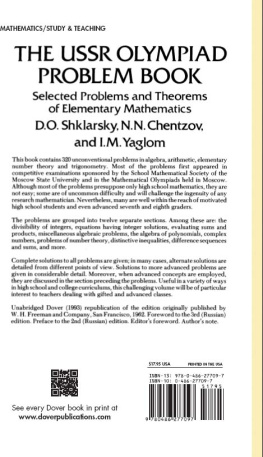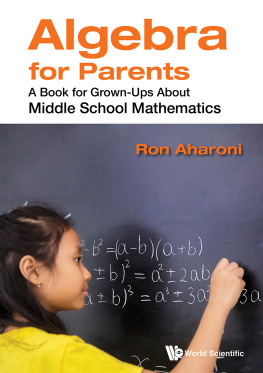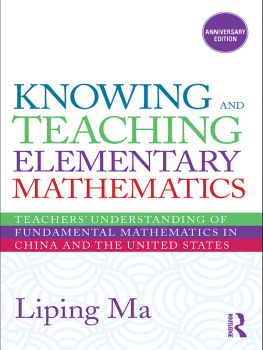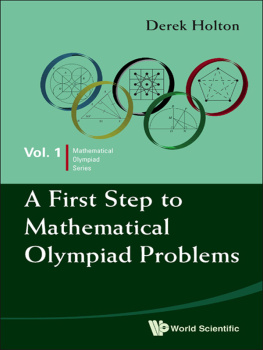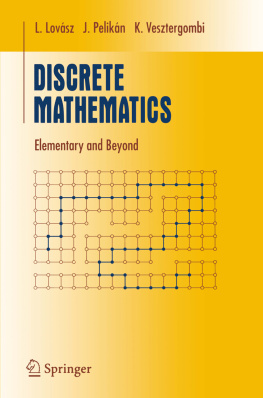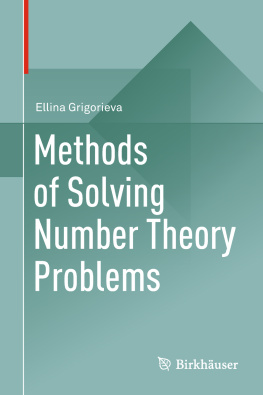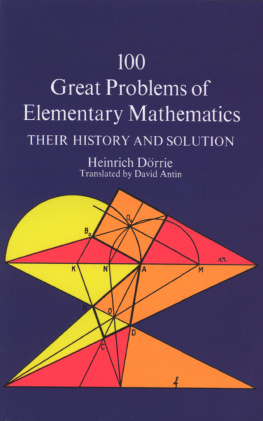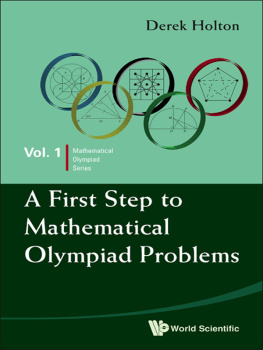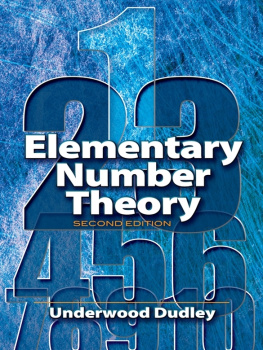THE USSR OLYMPIAD
PROBLEM BOOK
Selected Problems and Theorems
of Elementary Mathematics
D. O. SHKLARSKY
N. N. CHENTZOV
I. M. YAGLOM
REVISED AND EDITED BY
IRVING SUSSMAN,
University of Santa Clara
TRANSLATED BY
JOHN MAYKOVICH,
University of Santa Clara
DOVER PUBLICATIONS, INC.
NEW YORK
Bibliographical Note
This Dover edition, first published in 1993, is an unabridged and unaltered republication of the work first published by W.H. Freeman and Company, San Francisco, in 1962.
Library of Congress Cataloging-in-Publication Data
Shkliarski, D. O. (David Oskarovich), 19181942.
[Izbrannye zadachi i teoremy elementarno matematiki, ch 1. English]
The USSR Olympiad problem book : selected problems and theorems of elementary mathematics / D.O. Shklarsky, N.N. Chentzov, I.M. Yaglom ; translated by John Maykovich.3rd ed / rev. and edited by Irving Sussman.
p. cm.
ISBN-13: 978-0-486-27709-7
ISBN-10: 0-486-27709-7
1. MathematicsProblems, exercises, etc. I. Chentsov, N. N. (Nikolai Nikolaevich) II. IAglom, I. M. (Isaak Moiseevich), 1921. III. Sussman, Irving. IV. Title.
QA43.S5813 1994
510.76dc20
93-11553
CIP
Manufactured in the United States by Courier Corporation
27709710
www.doverpublications.com
FOREWORD TO THE
THIRD (Russian) EDITION
THIS BOOK CONTAINS 320 unconventional problems in algebra, arithmetic, elementary number theory, and trigonometry. Most of these problems first appeared in competitive examinations sponsored by the School Mathematical Society of the Moscow State University and in the Mathematical Olympiads) held in Moscow. The book is designed for students having a mathematical background at the high school level; very many of the problems are within reach of seventh and eighth grade students of outstanding ability. Solutions are given for all the problems. The solutions for the more difficult problems are especially detailed.
The third (Russian) edition differs from the second chiefly in the elimination of errors detected in the second edition. Therefore, the preface to the second edition is retained.
The level of academic attainment referred to as high school level is the American ninth to twelfth grades. The USSR equivalent is seventh to tenth grades. This means that this material is introduced about two years earlier in the Russian schools. Since Russian children begin their first grade studies about a year later than do American children, the actual age disparity is not as much as two years [Editor].
PREFACE TO THE
SECOND (Russian) EDITION
THE PRESENT VOLUME, which constitutes the first part of a collection, contains 320 problems involving principally algebra and arithmetic, although several of the problems are of a type meant only to encourage the development of logical thought (see, for example, ).
The problems are grouped into twelve separate sections. The last four sections (Complex Numbers, Some Problems from Number Theory, Inequalities, Numerical Sequences and Series) contain important theoretical material, and they may well serve as study topics for school mathematical societies or for the Society on Elementary Mathematics at the pedagogical institutes. In this respect the supplementary references given in various sections will also prove useful. All the other sections [especially Alterations of Digits in Integers and Solutions of Equations in Integers (Diophantine equations)] should yield material profitable for use in mathematics clubs and societies.
Of the twelve sections, only four (Miscellaneous Problems in Algebra, Polynomial Algebra, Complex Numbers, Inequalities) concern algebra; the remaining sections deal with arithmetic and number theory. A special effort has been made to play down problems (particularly those in algebra) involving detailed manipulative matter. This was done to avoid duplicating material in the excellent Problem Book in Algebra, by V. A. Kretchmar (Government Technical Publishing House, Moscow 1950). On the other hand, an effort has been made to render much of the book attainable to eighth grade, and even seventh grade, students.
More than three years have passed since the appearance of the first edition of this book. During this period the original authors received a great many written and oral communications with respect to it, and these have been seriously considered in the reworking of the material and in deciding which features were worth retaining and emphasizing and which aspects were weak. As a result, the book has undergone considerable revision. About sixty problems that were in the first edition have been omittedsome appeared to be too difficult, or were insufficiently interesting, and others did not fit into the new structure of the book. Approximately 120 new problems have been added. The placing of each problem into a suitable section has been restudied; the sections have been repositioned; all the solutions have been reworked (several were replaced by simplified or better solutions); and alternative solutions have been provided for some of the problems. Hints have been given for every problem, and those problems which to the authors appear of greater difficulty have been starred(*). Sections 3, 5, 6, 9, and 10 have undergone such significant changes that they may be considered as having been completely rewritten. Sections 1, 2, 4, 7, and 11 have been revised radically, and only Sections 8 and 12 have had relatively minor alterations.
The first edition of the book was prepared by I. M. Yaglom in collaboration with G. M. Adelson-Velsky (who contributed the section on alteration of digits in integers and also a number of problems to other sections, particularly to the section on Diophantine equations). An important contribution was made to the first edition by E. E. Balash (who contributed the section on numerical sequences and series) and Y. I. Khorgin (who made the principal contribution to the section on inequalities). Solutions for other problems were written by various directors of the School Mathematical Society of the Moscow State University. About 20 problems were taken from manuscripts of the late D. O. Shklarsky.
The rewriting of the book for the second edition was done by I. M. Yaglom, who made extensive use of the material of the first edition.
In conclusion, the author wishes to thank A. M. Yaglom, whose advice was of invaluable assistance while the book was being written and who initiated the rewriting of the section on complex numbers. The author is also indebted to the editor, A. Z. Rivkin, whose indefatigable labors on the first and second editions made possible many improvements, and to all the readers who made valuable suggestions, especially I. V. Volkova, L. I. Golovina, R. S. Guter, G. Lozanovsky, I. A. Laurya, Y. B. Rutitsky, A. S. Sokolin, and I. Y. Tanatar.
I. M. Yaglom
EDITORS FOREWORD TO THE
ENGLISH EDITION
One of the important facets of science education in the USSR has been their series of mathematical competitive examinations held for students of high ability in the secondary schools. Those contests, which are being emulated increasingly in our own educational system, culminate each year in the Soviet Union in their Mathematical Olympiads held at Moscow University, preliminary qualifying and elimination examinations having been held nationwide throughout the academic year.
This book, compiled over a twenty-year period, is a collection of the most interesting and instructive problems posed at these competitions and in other examination centers of the USSR, plus additional problems and material developed for use by the School Mathematics Study Societies. Perhaps the greatest compliment which can be paid to the problems created for this purpose by leading Soviet mathematicians (or taken and adapted from the literature) has been the extent to which the problems have been used in our own contests and examinations.

